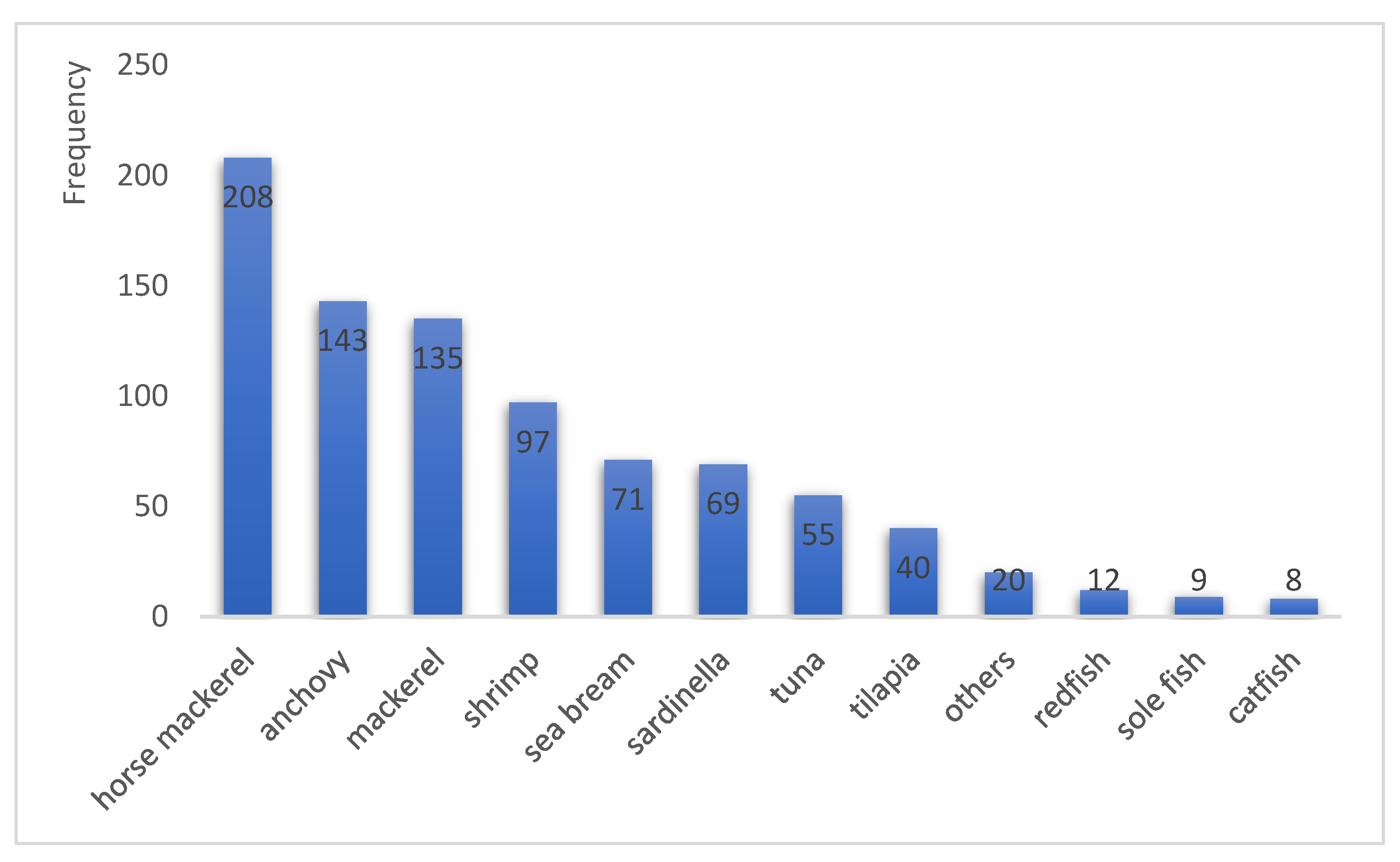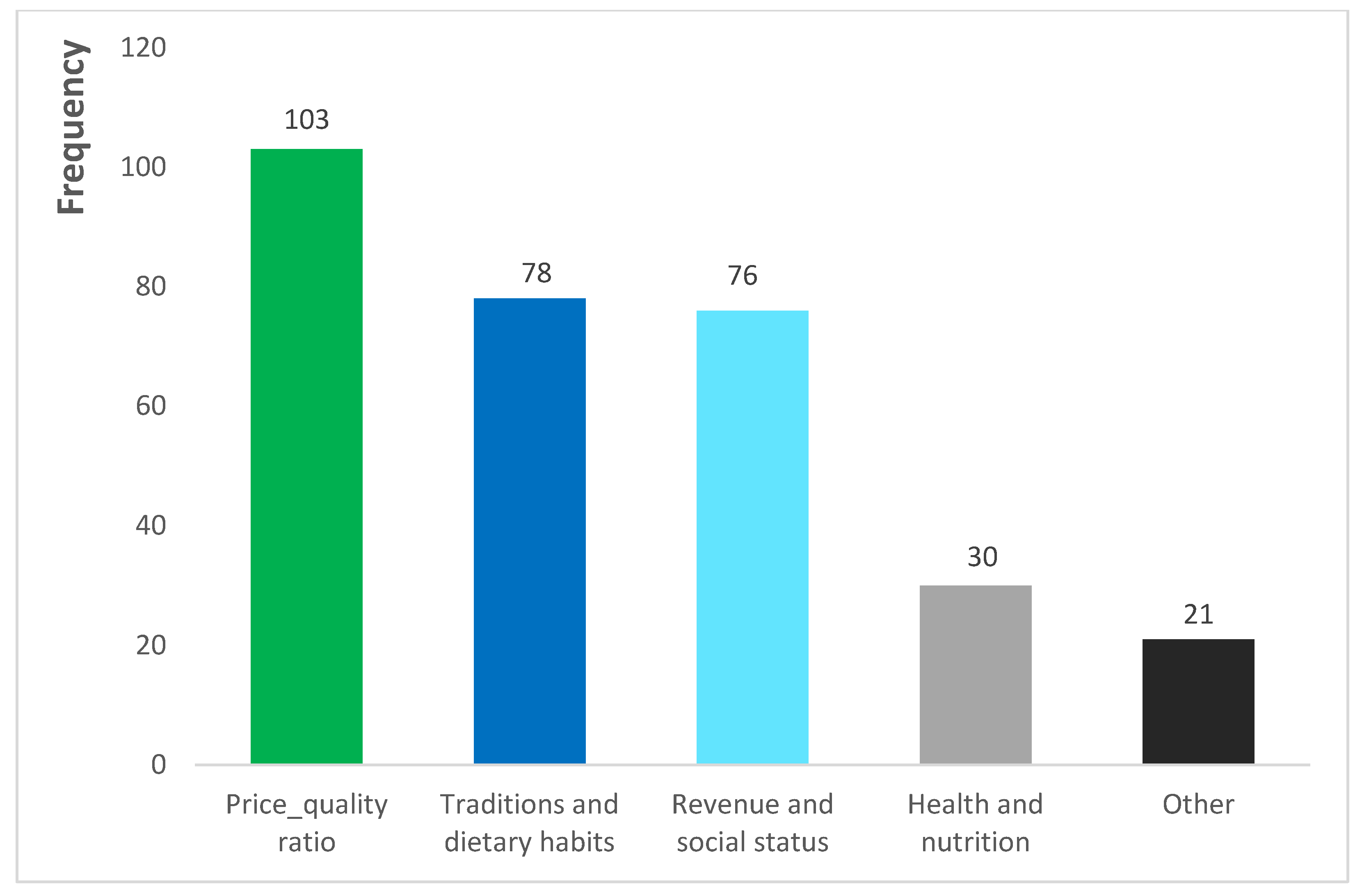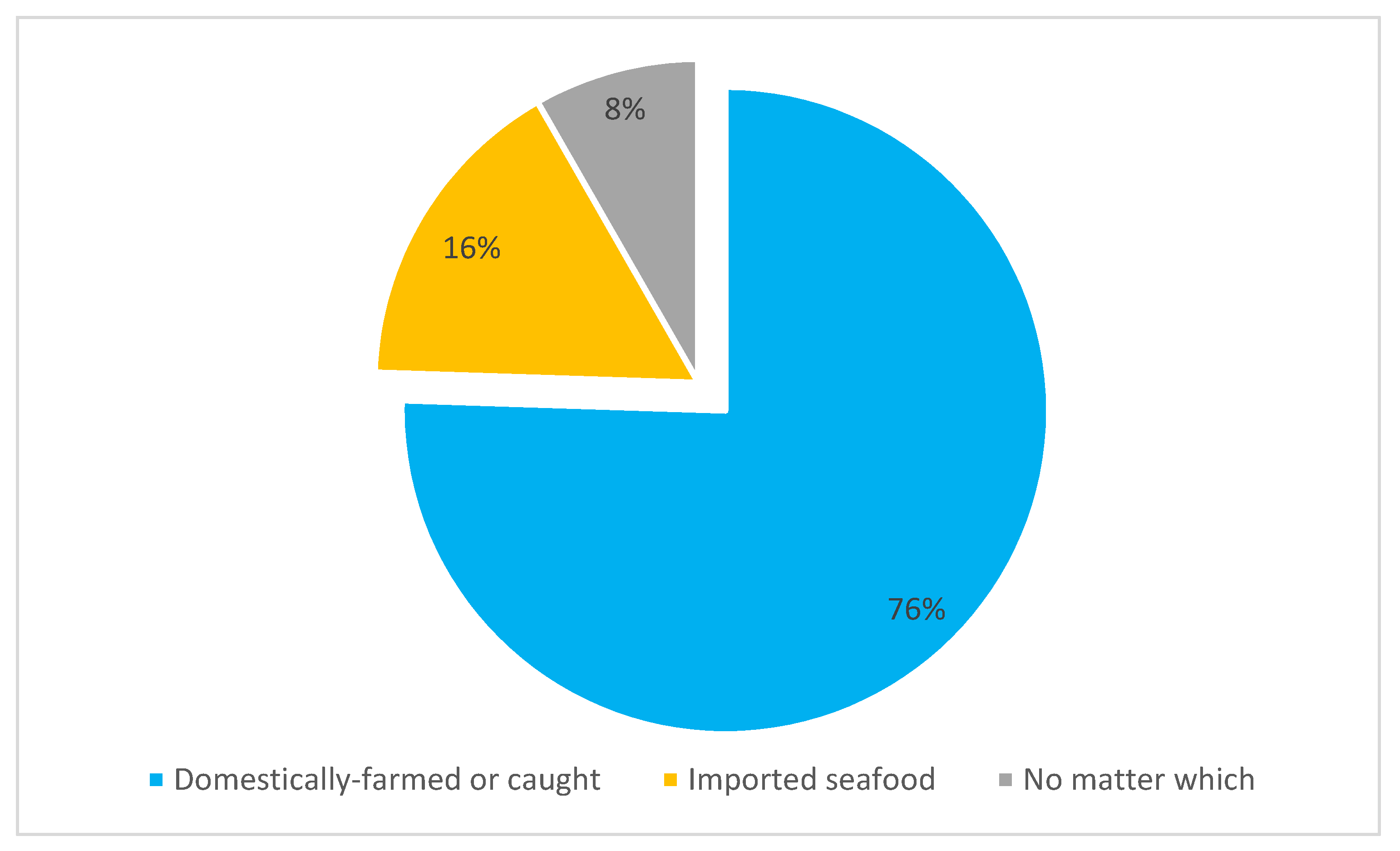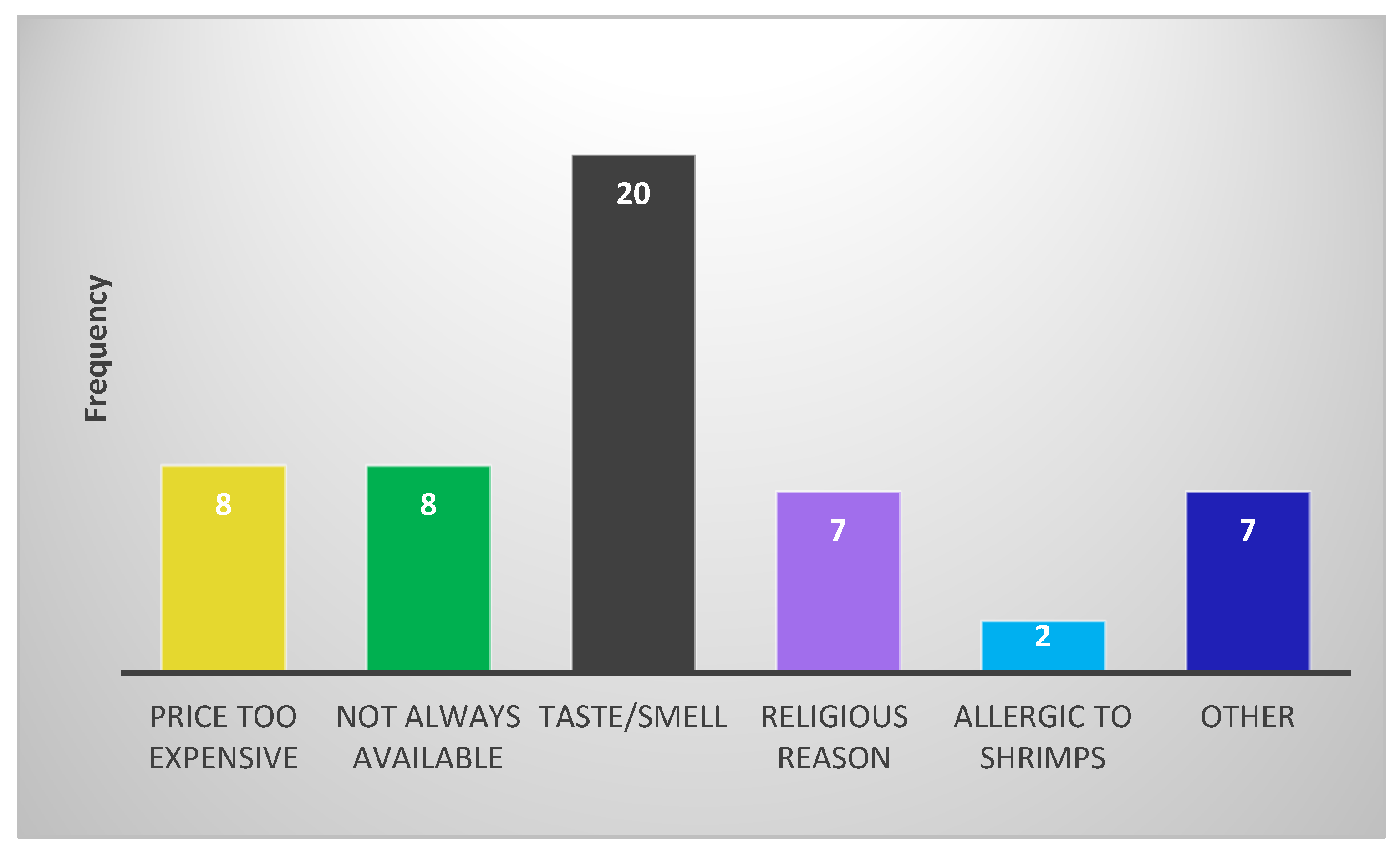Between Tradition, Strategies and Taste: Understanding Fish Consumption Habits in Togo
Abstract
:1. Introduction
2. Materials and Methods
2.1. Sampling and Data Collection
2.2. Models
2.2.1. Poisson Model
2.2.2. Heckman Selection Model and Willingness to Pay (WTP) for Shrimp Consumption
3. Results
3.1. Descriptive Results
3.1.1. Demographic Information
3.1.2. Reasons for Fish/Shrimp Purchasing and Consumption
3.1.3. Fish Origin and Provenance, “Local” vs. “Imported”
3.1.4. Obstacles to Shrimp Consumption
3.2. Econometric Results
3.2.1. Poisson Regression Model for Factors Influencing Fish Consumption Frequency
3.2.2. Willingness to Pay More for Locally Produced Shrimp
4. Discussion
5. Conclusions
Author Contributions
Funding
Institutional Review Board Statement
Informed Consent Statement
Data Availability Statement
Acknowledgments
Conflicts of Interest
References
- FAO. Évaluation des Pertes Après-Capture Dans les Pêcheries Maritimes Artisanales du Togo; FAO: Lomé, Togo, 2020. [Google Scholar] [CrossRef]
- Horemans, B. Politique de Développement et Programme d’Action—Définition d’Une Politique et d’Un Plan d’Action pour la Pêche; Projet TCP/TOG/34; Revue Sectorielle: Lomé, Togo, 1996. [Google Scholar]
- De Graaf, G.; Garibaldi, L. La Valeur des Pêches Africaines; FAO, Circulaire sur les Pêches et l’Aquaculture No.1093; FAO: Rome, Italy, 2014. [Google Scholar]
- FAO. Food and Agriculture Organization of United Nations, Togo Globefish Market Profile. 2019. Available online: https://www.fao.org/3/cb9842en/cb9842en.pdf (accessed on 29 August 2022).
- Mohanty, B.P.; Ganguly, S.; Mahanty, A.; Mitra, T.; Patra, S.; Karunakaran, D.; Suseela, M.; Chakraborty, K.; Paul, B.N.; Sarma, D.; et al. Fish. In Human Health and Nutrition: Advances in Fish Research, 1st ed.; Narendra Publishing House: Delhi, India, 2019; Chapter 11; Volume 7, pp. 189–218. [Google Scholar]
- Meena, D.K. Fish and Its Role in Human Nutrition. 2015. Available online: http://aquafind.com/articles/Fish-and-its-role-in-human-nutrition.php (accessed on 14 April 2022).
- Swanson, D.; Block, R.; Mousa, S.A. Omega-3 fatty acids EPA and DHA: Health benefits throughout life. Adv. Nutr. 2012, 3, 1–7. [Google Scholar] [CrossRef] [PubMed]
- Sun, G.Y.; Simonyi, A.; Fritsche, K.L.; Chuang, D.Y.; Hannink, M.; Gu, Z.; Greenlief, C.M.; Yao, J.K.; Lee, J.C.; Beversdorf, D.Q. Docosahexaenoic acid (DHA): An essential nutrient and a nutraceutical for brain healthand diseases. Prostaglandins Leukot. Essent. Fatty Acids 2018, 136, 3–13. [Google Scholar] [CrossRef] [PubMed]
- Rincón-Cervera, M.A.; González-Barriga, V.; Romero, J.; Rojas, R.; Sandra López-Arana, S. Quantification and Distribution of Omega-3 FattyAcids in South Pacific Fish and Shellfish Species. Foods 2020, 9, 233. [Google Scholar] [CrossRef]
- OECD/FAO. OECD-FAO Agricultural Outlook 2020–2029; FAO: Rome, Italy; OECD Publishing: Paris, France, 2020. [Google Scholar] [CrossRef]
- FAO. FAO Yearbook. Fishery and Aquaculture Statistics. 2015/FAO Annuaire. Statistiques des Pêches et de L’Aquaculture. 2015/FAO Anuario. Estadísticas de Pesca y Acuicultura; FAO: Rome, Italy, 2017. [Google Scholar]
- N’Souvi, K.; Sun, C.; Egbendewe-Mondzozo, A.; Tchakah, K.K.; Alabi-Doku, B.N. Analysis of the impacts of socioeconomic factors on hiring an external labor force in tilapia farming in Southern Togo. Aquac. Fish. 2021, 6, 216–222. [Google Scholar] [CrossRef]
- FAO—Food and Agriculture Organisation of United Nations. In Profils des Pêches et de l’Aquaculture par Pays, la République Togolaise; FAO: Rome, Italy, 2019; Available online: http://www.fao.org/fishery/facp/TGO/fr (accessed on 12 February 2021).
- Sedzro, K.M.; Fiogbe, E.D.; Guerra, E.B. Pêcheries maritimes artisanales togolaises: Analyse des débarquements et de la valeur commerciale des captures. J. Rech. Sci. L’Univ. Lomé 2017, 19, 2. [Google Scholar]
- N’Souvi, K.; Sun, C.; Zhang, H.; Broohm, D.A.; Okey, M.K.N. Fisheries and aquaculture in Togo: Overview, performance, fisheries policy, challenges and comparative study with Ghana, Mali, Niger and Senegal fisheries and aquaculture. Mar. Policy 2021, 132, 104681. [Google Scholar] [CrossRef]
- Onumah, E.E.; Quaye, E.A.; Ahwireng, A.K.; Campion, B.B. Fish Consumption Behaviour and Perception of Food Security of Low-Income Households in Urban Areas of Ghana. Sustainability 2020, 12, 7932. [Google Scholar] [CrossRef]
- Honkanen, P.; Olsen, S.O.; Verplanken, B. Intention to consume seafood-the importance of habit. Appetite 2005, 45, 161–168. [Google Scholar] [CrossRef]
- Verbeke, W.; Vackier, I. Individual determinants of fish consumption: Application of the theory of planned behaviour. Appetite 2005, 44, 67–82. [Google Scholar] [CrossRef]
- Zhou, L.; Jin, S.; Zhang, B.; Cheng, G.; Zeng, Q.; Wang, D. Determinants of fish consumption by household type in China. Br. Food J. 2015, 117, 1273–1288. [Google Scholar] [CrossRef]
- Lee, M.-K.; Nam, J. The determinants of live fish consumption frequency in South Korea. Food Res. Int. 2019, 120, 382–388. [Google Scholar] [CrossRef] [PubMed]
- Pulcini, D.; Franceschini, S.; Buttazzoni, L.; Giannetti, C.; Capoccioni, F. Consumer Preferences for Farmed Seafood: An Italian Case Study. J. Aquat. Food Prod. Technol. 2020, 29, 445–460. [Google Scholar] [CrossRef]
- Kitano, S.; Yamamoto, N. The role of consumer knowledge, experience, and heterogeneity in fish consumption: Policy lessons from Japan. J. Retail. Consum. Serv. 2020, 56, 102151. [Google Scholar] [CrossRef]
- Zhang, H.; Sun, C.; Wang, Z.; Che, B. Seafood consumption patterns and affecting factors in urban China: A field survey from six cities. Aquac. Rep. 2021, 19, 100608. [Google Scholar] [CrossRef]
- Lare, L.Y. La Consommation du Poisson Transforme au Togo: Entre Habitude et Stratégie Alimentaire. 2014. Available online: http://publication.lecames.org/index.php/hum/article/download/645/483 (accessed on 17 July 2022).
- FAO. Fish Consumption Survey—Mauritius; SmartFish-FAO Report; FAO: Rome, Italy, 2013; 85p. [Google Scholar]
- Hermida, M.; Costa, S. Between Tradition and Taste: Fish Consumption Habits in a Small Portuguese Archipelago. J. Aquat. Food Prod. Technol. 2020, 29, 335–349. [Google Scholar] [CrossRef]
- Hossain, M.S.; Hasan, M.M.; Sarwer, M.G.; Bhowmik, S. Comparative analysis of microbiological status between raw and ready-toeat product of black tiger shrimp (Penaeus monodon). Int. J. Biosci. 2015, 6, 43–49. [Google Scholar]
- Guillen, J.; Natale, F.; Carvalho, N.; Casey, J.; Hofherr, J.; Druon, J.-N.; Fiore, G.; Gibin, M.; Zanzi, A.; Martinsohn, J.T. Global seafood consumption footprint. Ambio 2019, 48, 111–122. [Google Scholar] [CrossRef]
- Murray, G.; Wolff, K.; Patterson, M. Why eat fish? Factors influencing seafood consumer choices in British Columbia, Canada. Ocean Coast. Manag. 2017, 144, 16–22. [Google Scholar] [CrossRef]
- Carlucci, D.; Nocella, G.; De Devitiis, B.; Viscecchia, R.; Bimbo, F.; Nargone, G. Consumer purchasing behavior towards fish and seafood products, Patterns and insights from a sample of international studies. Appetite 2015, 84, 212–227. [Google Scholar] [CrossRef]
- Mitterer-Daltoe, M.; Latorres, J.; Queiroz, M.; Fiszman, S.; Varela, P. Reasons underlying low fish consumption where availability is not an issue. A casy study in Brazil, one of the world’s largest fish producers. J. Sens. Stud. 2013, 28, 205–216. [Google Scholar] [CrossRef]
- Mitra, S.; Khatun, M.N.; Prodhan, M.M.H.; Khan, M.A. Consumer preference, willingness to pay, and market price of capture and culture fish: Do their attributes matter? Aquaculture 2021, 544, 737139. [Google Scholar] [CrossRef]
- Burger, J.; Stephens, W.L., Jr.; Boring, C.S.; Kuklinski, M.; Gibbons, J.W.; Gochfeld, M. Factors in exposure assessment: Ethnic and socioeconomic differences in fishing and consumption of fish caught along the Savannah River. Risk Anal. 1999, 19, 427–438. [Google Scholar] [CrossRef] [PubMed]
- Hicks, D.; Pivarnik, L.; McDermott, R. Consumer perceptions about seafood—An internet survey. J. Foodserv. 2008, 19, 213–226. [Google Scholar] [CrossRef]
- Can, M.F.; Gunlu, A.; Can, H.Y. Fish consumption preferences and factors influencing it. Food Sci. Technol. 2015, 35, 339–346. [Google Scholar] [CrossRef]
- Rahman, M.N.; Islam, A.R.M.T. Consumer fish consumption preferences and contributing factors: Empirical evidence from Rangpur city corporation, Bangladesh. Heliyon 2020, 6, e05864. [Google Scholar] [CrossRef]
- Hansen, A.L.; Grung, B. Fish Consumption and Heart Rate Variability. In Fish and Fish Oil in Health and Disease Prevention; Academic Press: Cambridge, MA, USA, 2016; pp. 231–238. [Google Scholar] [CrossRef]
- Moreau, M.A.; Garaway, C.J. Fish Rescue us from Hunger: The Contribution of Aquatic Resources to Household Food Security on the Rufiji River Floodplain, Tanzania, East Africa. Hum. Ecol. 2018, 46, 831–848. [Google Scholar] [CrossRef]
- Erasmus, V.N.; Kadhila, T.; Thyberg, K.; Kamara, E.N.; Bauleth-D’Almeida, G. Public perceptions and factors affecting domestic marine fish consumption in Namibia, Southwestern Africa. Reg. Stud. Mar. Sci. 2021, 47, 101921. [Google Scholar] [CrossRef]
- Oliveira, R.C.; Dórea, J.G.; Bernardi, J.V.; Bastos, W.R.; Almeida, R.; Manzatto, Â.G. Fish consumption by traditional subsistence villagers of the Rio Madeira (Amazon): Impact on hair mercury. Ann. Hum. Biol. 2010, 37, 629–642. [Google Scholar] [CrossRef]
- Qasim, M.; Qasim, S.; Nazir, N. Factors affecting fish consumption of traditional subsistence fishers in Khyber Pakhtunkhwa, Pakistan. Mar. Sci. Technol. Bull. 2020, 9, 178–187. [Google Scholar] [CrossRef]
- Yin, S.; Han, F.; Chen, M.; Li, K.; Li, Q. Chinese urban consumers’ preferences for white shrimp: Interactions between organic labels and traceable information. Aquaculture 2020, 521, 735047. [Google Scholar] [CrossRef]
- Hussein, M.; Silva, A.; Fraser, I. Linking intrinsic quality attributes of agricultural produce to revealed consumer preferences. Food Qual. Prefer. 2015, 41, 180–188. [Google Scholar] [CrossRef]




| Notation | Variable Name | Description | Variable Type/Criteria |
|---|---|---|---|
| Dependent Variable | |||
| FCF | Fish/shrimp consumption frequency | Count variable 0, 1, 2, 3 … n | |
| Independent variables | |||
| Price | Average price of seafood purchased/consumed | Continuous variable | |
| Quality | Quality of fish/shrimp often consumed | Binary variable: 1 = Good; 0 = bad. | |
| Household head income | Household monthly income | Continuous variable | |
| Proximity | Household living in area relatively near sea | Binary variable: 1 = Near; 0 = Far. | |
| Household size | Number of people in the household | Continuous variable | |
| Education | Years of schooling of the household head | Categorical variable: 0 = No formal education, 1 = Elementary school, 2 = Secondary, 3 = College | |
| Age | Age of the household head (in years) | Continuous variable | |
| Gender | Household head gender | Categorical: = 1 if the household head is female, 0 otherwise | |
| Item | Answer | % | Item | Answer | % |
|---|---|---|---|---|---|
| Monthly income | <60 US Dollars | 15.9 | Price of seafood consumed | <USD 1 | 26.9 |
| USD 60–148 | 27.3 | USD 1–USD 2 | 41.0 | ||
| USD 148–208 | 13.6 | USD 2–USD 3 | 18.8 | ||
| USD 208–248 | 7.5 | USD 3–USD 4 | 7.8 | ||
| USD 248–394 | 13.9 | USD 4–USD 6 | 5.2 | ||
| >USD 394 | 21.8 | >USD 6 | 0.3 | ||
| Household size | 1 people | 4.9 | Seafood quantity purchased | <2 kg (kg) | 48.1 |
| 2 people | 10.4 | 2–4 kg | 40.6 | ||
| 3 people | 16.2 | 4–5 kg | 6.8 | ||
| 4 people | 21.4 | >5 kg | 4.5 | ||
| 5 people | 17.5 | Seafood purchasing frequency (per month) | <4 times | 2.3 | |
| >5 people | 29.6 | 4–8 times | 10.1 | ||
| Gender | Male | 72 | 8–12 times | 28.2 | |
| Female | 28 | 12–16 times | 16.2 | ||
| Willingness to pay extra-costs for shrimp locally farmed | Yes | 65.6 | >16 times | 43.2 | |
| No | 34.4 |
| Frequency | Coef. | Std. Err. | z | p > z |
|---|---|---|---|---|
| Averag_price_USD | 0.0114 | 0.013284 | 0.86 | 0.389 |
| Quality | 0.1872 *** | 0.062391 | 3.00 | 0.003 |
| Household_Income | −0.0217 ** | 0.009049 | −2.40 | 0.016 |
| Proximity_Sea | −0.0775 ** | 0.032129 | −2.41 | 0.016 |
| Household_Size | 0.0102 | 0.006469 | 1.57 | 0.116 |
| Education | −0.0321 | 0.027747 | −1.16 | 0.247 |
| Age | 0.0011 | 0.014678 | 0.07 | 0.943 |
| Gender | −0.0537 | 0.034601 | −1.55 | 0.120 |
| cons | 2.6008 *** | 0.115069 | 22.60 | 0.000 |
| Price (Average) | Quality | H_Iincome | Proximity | H_Size | Edu | Age | Gender | |
|---|---|---|---|---|---|---|---|---|
| Price_average | 1.0000 | |||||||
| Quality | 0.0062 | 1.0000 | ||||||
| H_Income | 0.0864 | −0.0666 | 1.0000 | |||||
| Proximity | −0.0059 | 0.0260 | −0.0008 | 1.0000 | ||||
| H_size | −0.0530 | 0.0265 | 0.0626 | 0.0456 | 1.0000 | |||
| Edu | 0.0017 | −0.1036 | 0.335 ** | 0.136 * | −0.106 | 1.0000 | ||
| Age | −0.0165 | −0.0406 | 0.0378 | −0.0381 | 0.238 ** | −0.19 ** | 1.000 | |
| Gender | 0.0738 | −0.0081 | −0.0148 | −0.0357 | 0.1056 | −0.0849 | 0.053 | 1.000 |
| Coef. | Std. Err. | z | p > z | |
|---|---|---|---|---|
| WTP_Amount | ||||
| Income | 0.0043 | 0.0325 | 0.13 | 0.895 |
| Quality | 0.3462 ** | 0.1760 | 1.96 | 0.050 |
| Expenditure | 0.0605 | 0.0376 | 1.61 | 0.107 |
| Education | −0.0256 | 0.0933 | −0.27 | 0.784 |
| Age | −0.0826 * | 0.0496 | −1.67 | 0.096 |
| Gender | −0.0650 | 0.1119 | −0.58 | 0.561 |
| Cons | 1.1213 | 0.3788 | 2.96 | 0.003 |
| WTP | ||||
| Shrimp_Consumption | 1.2396 *** | 0.2131 | 5.81 | 0.000 |
| Quality | −0.3426 | 0.3126 | −1.10 | 0.273 |
| Income | −0.0807 | 0.0498 | −1.62 | 0.105 |
| Expenditure | 0.1794 *** | 0.0554 | 3.23 | 0.001 |
| Proximity | −0.2529 | 0.1625 | −1.56 | 0.120 |
| Education | 0.0720 | 0.1462 | 0.49 | 0.622 |
| Age | −0.0244 | 0.0739 | −0.33 | 0.740 |
| Gender | −0.1910 | 0.1740 | −1.08 | 0.281 |
| Cons | −0.5947 | 0.6002 | −0.99 | 0.322 |
| athrho | −0.1700 | 0.2761 | −0.62 | 0.538 |
| lnsigma | −0.3483 | 0.0543 | −6.42 | 0.000 |
| Rho | −0.1684 | 0.2683 | ||
| Sigma | 0.7058 | 0.0383 | ||
| Lambda | −0.1188 | 0.1920 |
Publisher’s Note: MDPI stays neutral with regard to jurisdictional claims in published maps and institutional affiliations. |
© 2022 by the authors. Licensee MDPI, Basel, Switzerland. This article is an open access article distributed under the terms and conditions of the Creative Commons Attribution (CC BY) license (https://creativecommons.org/licenses/by/4.0/).
Share and Cite
Che, B.; N’Souvi, K.; Sun, C.; Leibrecht, M.; Nantob, B. Between Tradition, Strategies and Taste: Understanding Fish Consumption Habits in Togo. Sustainability 2022, 14, 11475. https://doi.org/10.3390/su141811475
Che B, N’Souvi K, Sun C, Leibrecht M, Nantob B. Between Tradition, Strategies and Taste: Understanding Fish Consumption Habits in Togo. Sustainability. 2022; 14(18):11475. https://doi.org/10.3390/su141811475
Chicago/Turabian StyleChe, Bin, Kodjo N’Souvi, Chen Sun, Markus Leibrecht, and Bingainkiya Nantob. 2022. "Between Tradition, Strategies and Taste: Understanding Fish Consumption Habits in Togo" Sustainability 14, no. 18: 11475. https://doi.org/10.3390/su141811475
APA StyleChe, B., N’Souvi, K., Sun, C., Leibrecht, M., & Nantob, B. (2022). Between Tradition, Strategies and Taste: Understanding Fish Consumption Habits in Togo. Sustainability, 14(18), 11475. https://doi.org/10.3390/su141811475





